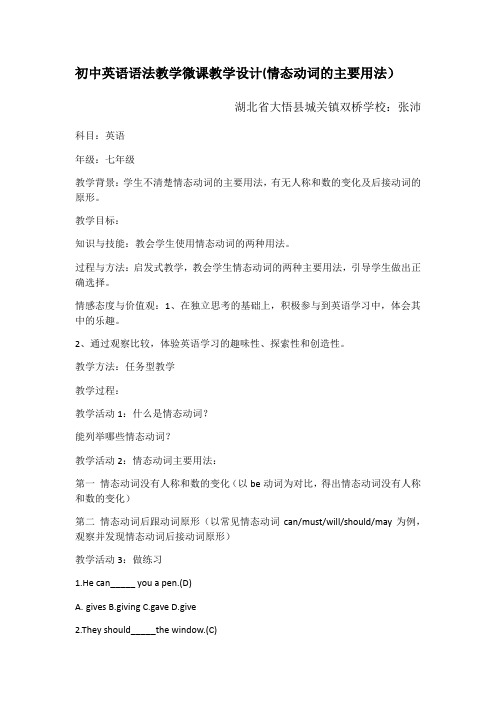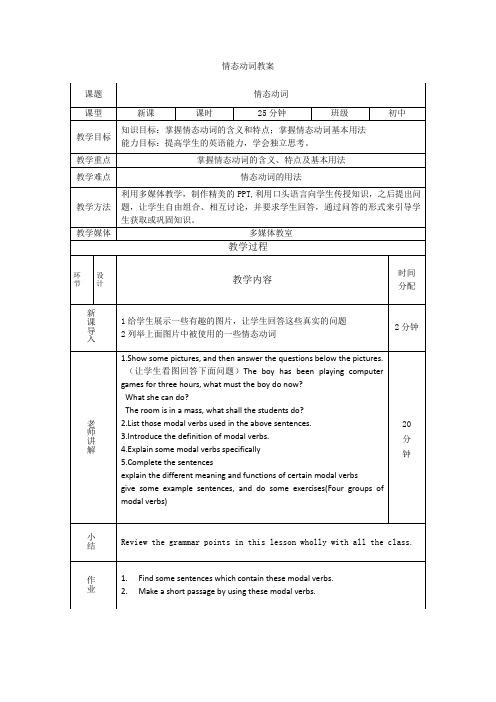初一升初二第十讲情态动词教案
- 格式:doc
- 大小:28.50 KB
- 文档页数:2

情态动词教案一、教学目标1. 理解情态动词的意义和用法,包括能力、权限、可能性、推测、建议等。
2. 掌握常见的情态动词,如can, could, may, might, must, should等的用法。
3. 能够正确运用情态动词来表达不同的语义。
4. 通过练习提高运用情态动词的能力。
二、教学准备1. 教师准备:课件、教材、白板、笔等。
2. 学生准备:课本、笔、笔记本等。
三、教学步骤1. 导入(5分钟)引导学生回顾动词的基本概念和运用,为学习情态动词做铺垫。
2. 介绍情态动词(10分钟)通过示意图和简短的解释,向学生介绍情态动词的定义和基本特点。
3. 情态动词的用法(15分钟)通过多个例句,讲解情态动词的不同用法,如表示能力、权限、可能性、推测和建议等。
4. 常用情态动词的用法(15分钟)介绍几个常用的情态动词,如can, could, may, might, must, should等,并给出相应的例句和用法解释。
5. 情态动词的练习(15分钟)让学生完成一些练习题,巩固对情态动词的掌握程度,同时培养运用情态动词的能力。
6. 情态动词的拓展运用(10分钟)鼓励学生在课堂上提出更多的例句和情态动词的用法,并进行讨论和分享。
7. 总结与评价(5分钟)总结本节课所学的内容,检查学生对情态动词的掌握情况。
四、课堂讨论在课堂上,教师可与学生进行互动性的讨论,如让学生用所学的情态动词来回答教师的问题,或者通过小组合作讨论,从不同的角度探讨情态动词的用法和意义。
五、拓展练习1. 在课堂上让学生完成一些情态动词的练习题,以培养他们的运用能力。
2. 布置一些家庭作业,要求学生写一篇文章,并在文章中运用情态动词来表达不同的意义和语境。
六、教学反思通过本节课的教学,学生能够理解情态动词的用法和意义,形成初步的运用能力。
在教学过程中,教师要注意引导学生主动思考、互动讨论,以巩固学生对情态动词的理解和应用。
此外,针对不同水平的学生,可以适当调整教学内容和难易程度,确保每个学生都能够受益于这堂课。

初中英语情态动词教案节日聚会的目的一、学习目标1. 了解并掌握情态动词can的用法;2. 能够用can表达能力和请求;3. 能够运用can提出邀请和请求;4. 能够用can回答邀请和请求。
二、教学重难点1. 情态动词can的用法;2. 能够运用can提出邀请和请求;3. 能够用can回答邀请和请求。
三、教学准备1. 多媒体设备;2. 课件和实物图片;3. 板书工具。
四、教学过程Step 1: 导入新课1. 教师拿出一张聚会邀请函,让学生猜测邀请函的内容,并引出Invitation(邀请)的概念。
2. 引出can的用法,例如:Teacher: Can you come to my party?Student: Yes, I can. / No, I can't.Teacher: Can you help me with my homework?Student: Yes, I can. / No, I can't.通过问题与回答的形式,让学生了解can的用法。
Step 2: 展示实物图片1. 教师展示一些实物图片,并向学生提出相关的邀请和请求,如:Teacher: Can you bring some drinks to the party?Student: Yes, I can. / No, I can't.通过实物图片的展示,让学生在情境中运用can。
2. 教师展示一张聚会的照片,向学生提问并引出更多的邀请和请求,如:Teacher: Can you help me decorate the room?Student: Yes, I can. / No, I can't.通过图片的展示,让学生在情境中运用can。
Step 3: 练习活动1. 教师出示课件上的几个情境,让学生组成小组,互相提出邀请和请求,并用can回答,并展示给全班。
2. 教师提问学生一些情境问题,并让学生运用can进行回答。

初中英语语法教学微课教学设计(情态动词的主要用法)
湖北省大悟县城关镇双桥学校:张沛科目:英语
年级:七年级
教学背景:学生不清楚情态动词的主要用法,有无人称和数的变化及后接动词的原形。
教学目标:
知识与技能:教会学生使用情态动词的两种用法。
过程与方法:启发式教学,教会学生情态动词的两种主要用法,引导学生做出正确选择。
情感态度与价值观:1、在独立思考的基础上,积极参与到英语学习中,体会其中的乐趣。
2、通过观察比较,体验英语学习的趣味性、探索性和创造性。
教学方法:任务型教学
教学过程:
教学活动1:什么是情态动词?
能列举哪些情态动词?
教学活动2:情态动词主要用法:
第一情态动词没有人称和数的变化(以be动词为对比,得出情态动词没有人称和数的变化)
第二情态动词后跟动词原形(以常见情态动词can/must/will/should/may为例,观察并发现情态动词后接动词原形)
教学活动3:做练习
1.He can_____ you a pen.(D)
A.gives
B.giving
C.gave
D.give
2.They should_____the window.(C)
A.opens
B.opening
C.open
D.opened
3.We must______ hard.(D)
A.studying
B.studies
C.studied
D.study。


初中教案教学情态动词的用法初中教案:教学情态动词的用法教学目标:1. 理解情态动词的概念及其在英语中的特殊用法;2. 掌握情态动词can、could、may、might、must、shall、should、will、would的用法;3. 能够正确运用情态动词表达能力、可能性、推测、义务、建议和意愿。
教学准备:1. 教师准备教案、教学材料;2. 学生准备笔记本和笔。
教学过程:一、引入(Introduction)(约15分钟)1. 向学生介绍情态动词的概念和作用,并通过例句解释情态动词在语境中的用法。
2. 提出问题,让学生思考:在英语中,情态动词用来表达哪些情感或语气?二、讲解(Explanation)(约30分钟)1. 逐一介绍情态动词can、could、may、might、must、shall、should、will、would的用法,包括:- 表达能力和技能的能力:can、could;- 表达可能性和推测:may、might;- 表达义务和必须:must、shall;- 表达建议和意愿:should、will、would。
2. 结合例句和练习,解释每种情态动词在不同语境中的具体运用方式。
鼓励学生参与讨论和提问。
三、实践(Practice)(约40分钟)1. 指导学生完成一系列练习,包括填空、改错和对话创作等,以巩固所学的情态动词用法。
2. 引导学生分组进行小组讨论,利用情态动词写出真实或虚构的句子,展示语言运用能力,并进行分享和讨论。
四、总结(Summary)(约10分钟)1. 对所学内容进行回顾和总结,强调情态动词的重要性和灵活运用;2. 总结情态动词的用法,并给出语境中常见的情态动词搭配。
五、拓展(Extension)(约10分钟)1. 鼓励学生进一步拓展所学知识,自主阅读相关课文或文章,寻找并归纳其他情态动词的用法;2. 提供相关练习或任务,巩固和扩展学生对情态动词的理解和运用能力。
六、作业(Homework)(约5分钟)布置适量的情态动词练习题,让学生课后进行巩固练习,并要求学生写一篇短文,运用情态动词描述自己的未来计划。

初中英语情态动词教案及解析一、选择题1.It’s amazing that the pen ________turn voice into text with few mistakes.A.can B.must C.may D.need2.Don’t cross the road until the traffic lights turn green. A car_______hit you.A.need B.may C.should D.must3.You ________ drive after drinking alcohol(酒). It’s against the law.A.mustn’t B.needn’t C.couldn’t D.wouldn’t4.You ________ be careful with the camera. It costs!A.can B.will C.should D.may 5.—Who’s singing next door? Is it Miss Wang?—It ________ be her. She’s having the boar d meeting.A.can’t B.shouldn’t C.mustn’t D.needn’t6.—Do we have to finish this today?—Yes, you ________ . Today is the last day.A.would B.may C.can D.must 7.Sorry, smoking is not allowed here. If you ________ , you will be fined according to the rules. A.can B.will C.may D.must 8.—There is a knock at the door.—It ________ be my mom. She always comes back home at this time.A.may B.may not C.must D.can’t9.—Be careful! Fire ________ be dangerous sometimes.—OK. I will put it out right away.A.mustn’t B.should C.can D.needn’t10.We shouldn’t throw any objects from the building. Even a small object ________ cause serious injuries or death, when dropped from a great height.A.must B.should C.may D.need11.You ________ write the report again because spelling mistakes are not allowed at all. A.must B.can C.may D.could12.—In China, many students have to stay up late to do their homework.—No worries. The government has realized the problem. I’m sure there ________ be good news soon.A.can B.should C.must D.need13.When you visit a museum, some instructions should ________ and we’d better not________ them.A.pay attention to; be against B.be paid attention; againstC.be paid attention to; against D.be paid attention to; be against 14.—How beautiful the winter jasmines (迎春花) are!—Yes. These golden-yellow flowers ________ be widely seen in my city in March.A.must B.can C.would D.should15.— Zoe, what do you think is the greatest advantage of shopping online?— At least I ______ spend much time going from shop to shop.A.shouldn’t B.can’t C.needn’t D.mustn’t 16.Please don't make so much noise. I ________ hear the speaker very well.A.needn't B.can't C.shouldn't D.mustn't 17.—The high school entrance examination is coming!—Yes, our teacher tells us we _______ be too careful while taking exams.A.mustn't B.shouldn't C.needn't D.can't18.We’ve discussed every detail of this plan and have got everything ready. But still something __________ go wrong. We still have to be very careful.A.must B.should C.would D.may19.When I was young, my father ___________ take me to climb the hill which was not far from our house.A.may B.must C.would D.should20.You ______ pay too much attention to your pronunciation, as it is so important in the oral (口头的) test.A.shouldn’t B.mustn’t C.can’t D.needn’t 21.—Shall we go camping this summer holiday?—Nothing________be better.A.should B.could C.must D.may22.My bike was broken yesterday,so I____walk home.A.might B.had to C.must D.could23.—Will your mother be at home this Saturday?—Hard to say. She _______go to the countryside to see my grandparents.A.must B.may C.can D.would24.Think twice before making a decision, or you __________ get into trouble.A.may B.can't C.shouldn't D.mustn't 25.—Where is Tom? I am considering ________ him about the result of the exam.—Oh. You ________. He has known it already.A.to tell; can't B.telling; needn't C.tell; mustn't D.told; shouldn't 26.—In China, many parents complain that their children have to stay up late to do the homework.—Don’t worry. The government has realized the problem. I’m sure there ________ be good news soon.A.can B.should C.need D.must 27.—Could I join you in the programme?—Sorry, you ________. You are too young.A.shouldn’t B.mustn’t C.can’t D.needn’t 28.—Who is singing next d oor? It sounds like a young girl’s voice.—It _________ be Jane. But she seldom sings English songs.A.need B.must C.may D.can29.To avoid ________, we’d better ________ the parents’ meeting online.A.gather; hold B.gathering; hold C.gather; holding D.to gather; to hold 30.Hurry up, or we ________ miss the beginning of the film.A.should B.must C.may D.have to 31.—Must the children leave at six tomorrow morning?—No, they _______. They can have more time to get ready for the trip.A.can’t B.needn’t C.mustn’t D.may not32.A hard-working man ________ become a great scientist, but a great scientist ________ be a hard-working man.A.can’t; can B.may not; must C.can’t; must D.may not; can 33.—What is that young lady’s job?—She ________ be a nurse, I’m not sure.A.must B.may C.need D.would34.— Listen! Tom ________ be listening to the music while doing his homework.—Let’s go upstairs to remind him to turn it off.A.should B.could C.would D.must 35.—Suzy described every detail of the accident just now.—Her memory ________ be completely back.A.shall B.need C.must D.could36.Never throw objects from the building. Even a small object ________ cause serious injuries, or death, when dropped from a great height.A.must B.should C.may D.need 37.—Who’s the man over th ere? Is that Mr. Black?—It ________ be him. Mr. Black is much taller than that man.A.may B.must C.can’t D.mustn’t 38.—Will Jim come to Yangzhou for a holiday?—He ________come and it depends on how much homework he will have.A.may B.should C.must D.need39.—Is it really necessary for me to go shopping with a mask on?—I’m afraid you ________ in public. It is not only to protect yourself but also to protect others. A.must B.should C.can D.need40.—Is it usually warm in Yancheng in May?—Yes. But it _______ be rather cold sometimes.A.must B.should C.would D.can41.When people are waiting at the zebra crossing, cars and buses ________ wait and let them go first.A.must B.may C.can D.need 42.—Must we stop the Japanese government discharging nuclear waste water (排放核污水)into the Pacific Ocean?—________. Because everyone should protect our earth and it is bad ________ us to eat the polluted seafood and drink the waste water.A.Yes, we can; of B.No, we mustn’t; of C.Yes, we must; for D.No, we needn’t; for 43.Look at the floor, Tom! ________ you watch TV while having a meal?A.Should B.Could C.Must D.May44.Cars ________ give way to walkers on some roads in Binhai, or the drivers will be fined. A.may B.will C.can D.must 45.Sometimes smiles ________ be false, hiding other feelings like anger, fear or worry. A.should B.would C.must D.can46.You’ve got an A in the maths test again. You ________ be good at it.A.can B.may C.must D.should 47.—Could you tell me how to renew the library books?—With pleasure. You ________ come to our desk every time. It’s easier to renew them online. A.can’t B.mustn’t C.needn’t D.shouldn’t 48.For the safety of the passengers, objects like guns ________ be carried on board.A.may not B.needn’t C.might not D.mustn’t 49.—The article says t hat a person’s animal sign decides his personality.—You ________ read it for fun, but don’t believe in that.A.can B.must C.shouldn’t D.needn’t 50.Most young people like shopping online because they ________ spend much time going from shop to shop.A.need n’t B.can’t C.mustn’t D.shouldn’t【参考答案】***试卷处理标记,请不要删除一、选择题1.A解析:A【详解】句意:神奇的是,这支笔能把声音转换成文字,而且很少出错。
初中情态动词教学设计 教学目标:通过情态动词的教学,使学生能够正确理解和运用情态动词,准确表达自己的态度和意愿。
教学内容: 1. 情态动词的基本概念和用法介绍 2. 情态动词的否定形式和疑问形式 3. 情态动词的情态助动词结构 4. 情态动词与情态助动词的区别 教学步骤: Step 1:引入 通过图片、视频或真实场景引导学生感知情态动词的应用,并带入情态动词的概念。
Step 2:基本概念和用法介绍 首先,通过例句和语境,引导学生理解情态动词强调说话人的意愿、能力、推测等态度。然后,讲解情态动词的基本用法和常见情态动词的意义。例如 can表示能力,may表示允许,should表示应该等。
Step 3:情态动词的否定形式和疑问形式 介绍情态动词的否定形式和疑问形式的构成和用法。通过对比肯定句、否定句和疑问句的例子,让学生掌握情态动词在不同语境下的变化。
Step 4:情态动词的情态助动词结构 讲解情态动词的情态助动词结构,并通过例句的方式进行巩固训练。引导学生根据给定的情境,使用情态动词的情态助动词结构进行表达。
Step 5:情态动词与情态助动词的区别 比较和对比情态动词与情态助动词的区别,帮助学生理解两者的不同用法和意义。通过举例和练习,训练学生在实际运用中的区分能力。
Step 6:综合运用与总结 设计综合性的情景对话或小组活动,让学生能够运用所学的情态动词知识进行真实情境的交流。同时,进行课堂小结,强调情态动词的重要性和灵活运用。
Step 7:拓展应用 布置课后作业,要求学生运用情态动词完成一篇短文或对话,进一步巩固所学内容。
教学辅助工具:图片、视频、例句、情景对话、小组活动、作业布置等。
教学评价: 1. 课堂表现:观察学生在课堂上的参与度、抓住重点的能力、表达能力等。
2. 作业评价:针对学生的课后作业进行批改,评价其运用情态动词的准确性和灵活性。
教学反思: 1. 在引入部分,应该选择能够引起学生兴趣的素材,让学生主动参与到教学中。
初中英语助动词和情态动词教案一、教学目标1. 掌握助动词do、does、did的用法和变化规则。
2. 理解情态动词can、could、may、might、shall、should、will、would、must、need的用法和意义。
3. 能够正确运用助动词和情态动词进行语言表达。
二、教学重点1. 助动词do、does、did的基本用法和时态变化。
2. 情态动词can、could、may、might、shall、should、will、would、must、need的基本用法和意义。
三、教学难点1. 助动词和情态动词的细微用法差别。
2. 情态动词在不同语境下的意义变化。
四、教学准备多媒体课件、黑板、教材、习题集等。
五、教学过程Step 1: 引入新知1. 教师通过举例子的方式引入助动词的概念,并与学生一起总结助动词的作用和形式。
2. 教师给出助动词do、does、did的用法和时态变化规则,并解释其用法差异。
Step 2: 助动词的用法1. 教师通过多个例句的呈现,进一步加深学生对助动词用法的理解。
2. 教师引导学生进行练习,正确填写句子中适当的助动词。
Step 3: 引入情态动词1. 教师展示情态动词can的用法和意义,并通过实际情境引导学生理解其含义。
2. 教师给出情态动词can、could、may、might的用法及其意义,并帮助学生区分它们之间的微妙差别。
Step 4: 情态动词的用法1. 教师通过语境示例,让学生了解情态动词shall、should、will、would、must、need的用法和意义。
2. 教师设计练习题,让学生根据不同的情境,填入适当的情态动词。
3. 教师逐一解析练习题答案,并给予必要的指导和讲解。
Step 5: 总结和归纳1. 教师与学生共同总结助动词和情态动词的用法和时态变化规则,并强调其在英语语言表达中的重要性。
2. 教师鼓励学生积极运用所学知识,形成正确的语言习惯。
#### 教学目标1. 知识目标:学生能够掌握情态动词的基本用法,包括can, may, must, should, need等。
2. 能力目标:学生能够运用情态动词进行日常对话,表达请求、建议、允许、能力、义务等。
3. 情感目标:培养学生对英语学习的兴趣,提高学生的跨文化交际意识。
#### 教学重点1. 情态动词的用法和含义。
2. 情态动词的否定和疑问句形式。
#### 教学难点1. 情态动词的细微差别和用法。
2. 在实际语境中正确运用情态动词。
#### 教学准备1. 多媒体课件。
2. 练习材料。
3. 小组活动道具。
#### 教学过程##### 一、导入新课1. 活动:教师通过图片或视频展示不同情境下的英语对话,引导学生思考这些对话中可能使用的情态动词。
2. 提问:What can we see in the picture? Can you guess what they are talking about?##### 二、新课讲授1. 介绍情态动词:- can:表示能力、允许或请求。
- may:表示可能性、请求或允许。
- must:表示必须、肯定或命令。
- should:表示建议、义务或期望。
- need:表示需要或必须。
2. 举例说明:- 使用例句展示情态动词的用法,如:You can go to the library. (你可以去图书馆。
)- 通过对比不同的情态动词,让学生理解它们之间的区别。
3. 语法讲解:- 讲解情态动词的否定形式和疑问句形式,如:You can't go to the party. (你不能去派对。
)- You may go to the party. (你可以去派对。
)- Must you finish your homework now? (你现在必须完成作业吗?)##### 三、课堂练习1. 填空练习:让学生根据句意填写合适的情态动词。
2. 对话练习:分组进行对话练习,运用情态动词进行日常交流。
新课讲解情态动词情态动词的定义: 情态动词是一种本身有一定的词义,表示说话人的情绪,态度或语气的动词,但不能单独作谓语, 只能和其他动词原形构成谓语。
We can be there on time tomorrow. 我们明天能按时去那儿。
May I have your name? 我能知道你的名字吗?Shall we begin now? 我们现在就开始吗?You must obey the school rules.你必须遵守校规。
情态动词数量不多,但用途广泛,主要有下列:can (could), may (might), must, need, ought to, dare (dared), shall (should), will (would) .情态动词的位置: 情态动词在句中放在谓语动词之前, 谓语动词前若有助动词,则在助动词之前,疑问句中, 情态动词则在主语之前。
I can see you. Come here. 我能看见你,过来吧。
He must have been away.他一定走了。
What can I do for you? 你要什么?How dare you treat us like that!你怎能那样对待我们!情态动词的特点: 情态动词无人称和数的变化, 情态动词后面跟的动词需用原形,否定式构成是在情态动词后面加"not"。
个别情态动词有现在式和过去式两种形式, 过去式用来表达更加客气, 委婉的语气, 时态性不强, 可用于过去,现在或将来。
He could be here soon. 他很快就来。
We can't carry the heavy box. 我们搬不动那箱子。
I'm sorry I can't help you. 对不起,我帮不上你。
1.Can/could(1)can 一般表示体,脑力方面的能力,意为“能,会(做某事)”,也可用来表示客观的可能性,意为“可以,可能”。
要考试,找戴氏 戴氏教育名师中心 主讲人:何敏
第十讲:情态动词
教学目标
1、 让学生掌握情态动词有哪些。
2、 让学生掌握各情态动词的用法。
教学重点难点
1、 学生能够掌握各情态动词的用法。
2、 学生能够正确运用易混淆的情态动词。
教学过程
Step1 问好,口语表达
Step2 复习上节课所学知识
Step3 教学内容
A 情态动词有哪些?
Can, could, may, might, must, shall, should, need, will, would, dare, had better, have to, used to.
B 各情态动词的用法
(1)Can: 表能力,“能,会”;
表可能,通常用于否定句和疑问句中,This boat can’t be hers, hers is black.
(2)could:表can的过去式;
表请求允许,用于现在时和将来时,比can更委婉地提出请求。
(3)May: 表猜测,“可能”(只能用于肯定句,否定句用can’t)
表征求同意,May I come in?
(4)Might: may的过去式;
might比may更加委婉。
(5)Must: 表义务的“必须” 表事情的必要性和重要性。 You must take care of your parents.
表推测的“一定,准是”(只有肯定猜测,否定猜测用can’t) The lady must be a
doctor.
(6)Shall: 用于第一人称的疑问句中,表示征询意见。
“应该”,多用于法律等条文中。
(7)Should: 表义务或责任“应该”。
(8)Need: 表必要性。
(9)Will: 表“意愿,意志”
(10)Would: will的过去式;
表示意愿或用于第二人称的疑问句中,表礼貌委婉的请求,比can更委婉。
(11)Had netter: 最好, (had better not)
(12)Have to: “不得不” (don’t have to Do+s+have to )
(13)Used to: 过去常常 (usedn’t to / didn’t used to / Did + s+ use to)
C 易混的情态动词
(1)Can/ could 与be able to: 表“能力”时
can只有现在和过去时两种时态,其余时态用be able to,
can指与生俱来的能力,be able to后天形成的能力。
(2)May开头的疑问句的回答:
肯定回答用may,
否定回答用can’t / mustn’t /had better not
(3)Must与have to:
要考试,找戴氏 戴氏教育名师中心 主讲人:何敏
must强调主观上的意志和决心,
have to表客观条件作用下得“不得不”
(4)Must开头的疑问回答:
肯定用must,
否定用 needn’t / don’t have to
(5)Must 的否定形式:mustn’t “不许,禁止”(must表推测时无否定形式,否定猜测
用can’t)
(6)Need:作实义动词时,后接名词、动名词、动词不定式 She doesn’t need to take any
medicine.
作情态动词时后接动词原形。
(7)Used to do与be used to doing :
used to do过去常常做但是现在不做了
be used to doing:习惯于、、、